Physical Inventory section.
Count Tags section.
Count Tags are used to spearhead Inventory counts. They are created manually and on-demand, and they are not tied to any particular cycle or frequency, as Cycle Count Tags are. To create Count Tags by Planner Code, select the "Create Count Tags by Planner Code" option. The following screen will appear:
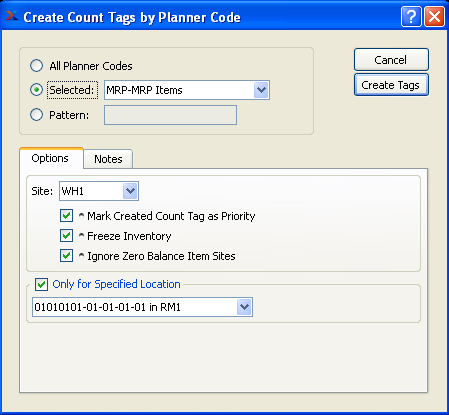
When creating Count Tags by Planner Code, you are presented with the following options:
Tip
By default, the system allows only one unposted Count Tag per Item Site. To view all unposted Count Tags in your system, see the Count Tag Edit List.
- All Planner Codes
Select to create Count Tags for all Planner Codes.
- Selected
Specify Planner Code you want to create Count Tags for.
- Pattern
Enter a Planner Code pattern to select a range of Planner Codes. Refine your search using Regular Expressions.
- Site
Specify Site the Count Tags are to be created for.
- Mark Created Count Tag as Priority
Select to give priority status to Count Tag. Count Tags marked as having priority status are listed first in any prioritized lists. For example, priority Count Tags will appear at the top of the Count Tag Edit List; whereas, non-priority Count Tags will appear at the bottom of the list.
- Freeze Inventory
Select to freeze Inventory. The Quantity on Hand value is not updated when a transaction is posted against a frozen Item Site. Instead, Inventory transactions are pooled and then posted later when the Item Site is unfrozen—or thawed. The Quantity on Hand is later updated when the Item Site is thawed.
Note
When an Item Site is frozen, any Inventory transactions entered against that Item Site—including Work Orders—will not change Quantity on Hand until after the Item Site is thawed.
- Ignore Zero Balance Item Sites
Select to ignore Item Sites which have a Quantity on Hand balance of zero. If selected, Count Tags will not be created for any Item Site having a Quantity on Hand balance of zero.
- Only for Specified Location
Select if you want to create Count Tags for an individual Site Location. If selected, you will have the option to specify which Site Location you want to have Count Tags created for. This option enables you to count individual Site Locations separately, without having to post counts for an entire Site all at once.
- Comments
This is a scrolling text field with word-wrapping for entering Comments related to the Count Tag. Use the Comments field to enter any instructions or other Comments that need to reach and be read by the Inventory counters.
To the far right of the screen, the following buttons are available:
- CANCEL
Closes the screen without creating Count Tags, returning you to the application desktop.
- CREATE TAGS
Creates Count Tags. Count Tag Numbers are generated automatically in an ordered sequence.
Count Tags are used to spearhead Inventory counts. They are created manually and on-demand, and they are not tied to any particular cycle or frequency, as Cycle Count Tags are. To create Count Tags by Class Code and Site, select the "Create Count Tags by Class Code/Site" option. The following screen will appear:
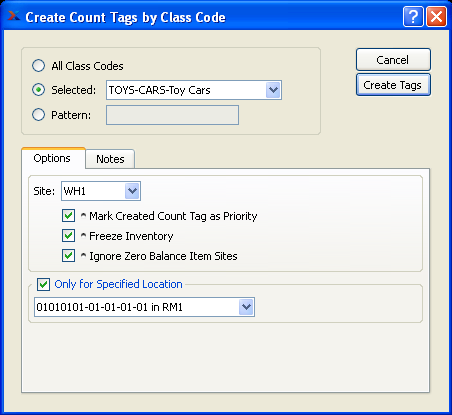
When creating Count Tags by Class Code and Site, you are presented with the following options:
Tip
By default, the system allows only one unposted Count Tag per Item Site. To view all unposted Count Tags in your system, see the Count Tag Edit List.
- All Class Codes
Select to create Count Tags for all Class Codes.
- Selected
Specify Class Code whose you want to create Count Tags for.
- Pattern
Enter a Class Code pattern to select a range of Class Codes. Refine your search using Regular Expressions.
- Site
Specify Site the Count Tags are to be created for.
- Mark Created Count Tag as Priority
Select to give priority status to Count Tag. Count Tags marked as having priority status are listed first in any prioritized lists. For example, priority Count Tags will appear at the top of the Count Tag Edit List; whereas, non-priority Count Tags will appear at the bottom of the list.
- Freeze Inventory
Select to freeze Inventory. The Quantity on Hand value is not updated when a transaction is posted against a frozen Item Site. Instead, Inventory transactions are pooled and then posted later when the Item Site is unfrozen—or thawed. The Quantity on Hand is later updated when the Item Site is thawed.
Note
When an Item Site is frozen, any Inventory transactions entered against that Item Site—including Work Orders—will not change Quantity on Hand until after the Item Site is thawed.
- Ignore Zero Balance Item Sites
Select to ignore Item Sites which have a Quantity on Hand balance of zero. If selected, Count Tags will not be created for any Item Site having a Quantity on Hand balance of zero.
- Only for Specified Location
Select if you want to create Count Tags for an individual Site Location. If selected, you will have the option to specify which Site Location you want to have Count Tags created for. This option enables you to count individual Site Locations separately, without having to post counts for an entire Site all at once.
- Comments
This is a scrolling text field with word-wrapping for entering Comments related to the Count Tag. Use the Comments field to enter any instructions or other Comments that need to reach and be read by the Inventory counters.
To the far right of the screen, the following buttons are available:
- CANCEL
Closes the screen without creating Count Tags, returning you to the application desktop.
- CREATE TAGS
Creates Count Tags. Count Tag Numbers are generated automatically in an ordered sequence.
Count Tags are used to spearhead Inventory counts. They are created manually and on-demand, and they are not tied to any particular cycle or frequency, as Cycle Count Tags are. To create a Count Tag by Item, select the "Create Count Tag by Item" option. The following screen will appear:
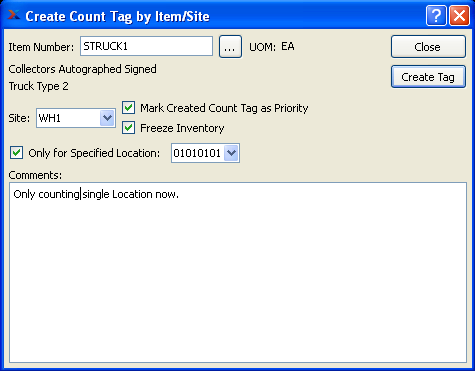
When creating Count Tags by Item, you are presented with the following options:
Tip
By default, the system allows only one unposted Count Tag per Item Site. To view all unposted Count Tags in your system, see the Count Tag Edit List.
- Item Number
Enter the Item Number of the Item you want to create a Count Tag for. The browse button located to the right of the field leads to a searchable list of make and buy items.
- UOM
Inventory Unit of Measure.
- Site
Specify the Site you want the Count Tag created for. This field will remain blank until you enter an Item Number into the "Item Number" field. Once that is entered, the Site(s) where the Item is located will display in the list.
- Mark Created Count Tag as Priority
Select to give priority status to Count Tag. Count Tags marked as having priority status are listed first in any prioritized lists. For example, priority Count Tags will appear at the top of the Count Tag Edit List; whereas, non-priority Count Tags will appear at the bottom of the list.
- Freeze Inventory
Select to freeze Inventory. The Quantity on Hand value is not updated when a transaction is posted against a frozen Item Site. Instead, Inventory transactions are pooled and then posted later when the Item Site is unfrozen—or thawed. The Quantity on Hand is updated when the Item Site is thawed.
Note
When an Item Site is frozen, any Site activity entered against that Item Site—including Work Orders—will use the Quantity on Hand shown at the time of freezing.
- Only for Specified Location
Select if you want to create Count Tags for an individual Site Location. If selected, you will have the option to specify which Site Location you want to have Count Tags created for. This option enables you to count individual Site Locations separately, without having to post counts for an entire Site all at once.
Note
An Item must have Multiple Location Control (MLC) turned ON to take advantage of the Count Tags by Location feature. If the Item is not multiply-located, then this option will not be available.
To the far right of the screen, the following buttons are available:
- CLOSE
Closes the screen without creating a Count Tag, returning you to the application desktop.
- CREATE TAG
Creates Count Tag. Count Tag Numbers are generated automatically in an ordered sequence.
Cycle Count Tags are used to count Inventory on a frequent basis, with the rate of frequency defined in the Item Site master. The following criteria are used to determine the order in which Cycle Count Tags will be created for a specified Site(s):
The system scans the Item Site masters in the specified Site(s), specifically targeting Cycle Count frequency settings.
The frequency settings are then compared to the last counted dates for each Item Site to determine which Item Sites have last counted dates most out of sync with their count frequency rate; Item Sites whose last counted dates are most out of sync with their stated frequency rate will have Cycle Count Tags created for them first.
After frequency and last counted date parameters have been considered, the Item Site's ABC Class is used—with A Class Item Sites having Cycle Count Tags created first.
Then, finally, Cycle Count Tags are created based on the Item Numbers for the Item Sites in ascending order (i.e., 1, 2, 3 ... A, B, C).
The total number of Cycle Count Tags to be created is determined beforehand.
The difference between Cycle Count Tags and Count Tags is that Cycle Count Tags are generated dynamically, using the criteria listed above. Count Tags are generated manually, on demand.
Tip
To monitor the frequency of Item Site Cycle Counts, view the "Last Counted" column in any of the Item Site Reports: by Item, by Class Code, etc. The Last Counted date represents the date a Count Tag was last posted (not simply issued) for the Item Site.
To create Cycle Count Tags by Site, select the "Create Cycle Count Tags by Site" option. The following screen will appear:

When creating Cycle Count Tags by Site, you are presented with the following options:
- Item Sites in
Specify which of the following codes you want to have Cycle Count Tags created for:
- Class Code
If selected, you will be presented with Class Code options.
- Planner Code
If selected, you will be presented with Planner Code options.
- Site
Specify Site where Cycle Count will be conducted.
- Mark Created Count Tag as Priority
Select to give priority status to Count Tag. Count Tags marked as having priority status are listed first in any prioritized lists. For example, priority Count Tags will appear at the top of the Count Tag Edit List; whereas, non-priority Count Tags will appear at the bottom of the list.
- Freeze Inventory
Select to freeze Inventory. The Quantity on Hand value is not updated when a transaction is posted against a frozen Item Site. Instead, Inventory transactions are pooled and then posted later when the Item Site is unfrozen—or thawed. The Quantity on Hand is updated when the Item Site is thawed.
Note
When an Item Site is frozen, any Site activity entered against that Item Site—including Work Orders—will use the Quantity on Hand shown at the time of freezing.
- Ignore Zero Balance Item Sites
Select to ignore Item Sites which have a Quantity on Hand balance of zero. If selected, Count Tags will not be created for any Item Site having a Quantity on Hand balance of zero.
- Maximum Number of Tags to Create
Select a number using the arrow buttons, or manually enter a value up to a maximum of 1,000.
- Only for Specified Location
Select if you want to create Count Tags for an individual Site Location. If selected, you will have the option to specify which Site Location you want to have Count Tags created for. This option enables you to count individual Site Locations separately, without having to post counts for an entire Site all at once.
- Comments
This is a scrolling text field with word-wrapping for entering Comments related to the Cycle Count. Use the Comments field to enter any instructions or other Comments that need to reach and be read by the cycle counters.
To the far right of the screen, the following buttons are available:
- CLOSE
Closes the screen without creating a Count Tag, returning you to the application desktop.
- CREATE TAGS
Creates Cycle Count Tags. Cycle Count Tag Numbers are generated automatically in an ordered sequence.
Count Slips are used for contributing Inventory count totals to unposted Count Tags. Unlike Count Tags, however, Count Slips do not have to be created before they can be entered. To enter a Count Slip, select the "Enter Count Slip" option. The following screen will appear:
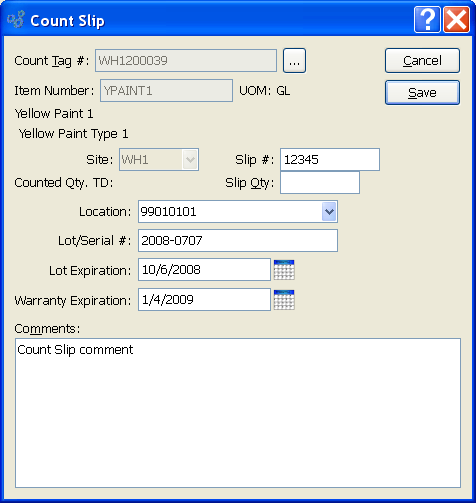
When entering a Count Slip, you are presented with the following options:
Tip
Restrictions may be imposed on the creation of Count Slips. To learn more, see Section 12.2, “Configure Inventory”.
- Count Tag #
Enter the Count Tag Number of the Count Tag you want to enter a Count Slip toward.
- Item Number
Displays Item Number automatically when Count Tag Number is entered into "Count Tag #" field.
- UOM
Inventory Unit of Measure.
- Site
Specify Site where count is being conducted.
- Counted Qty. TD
Displays total for specified Count Tag to date.
- Slip #
Enter a Count Slip Number to identify the Count Slip. Some restrictions may apply. To learn more about Count Slip numbering restrictions, see Section 12.2, “Configure Inventory”.
- Slip Qty
Enter the Physical Count total.
- Location
Specify the Location you want the Count Slip created for. The list will show all valid Site Locations for the specified Item.
- Lot/Serial #
Displays related Lot/Serial Number information, if applicable.
- Lot Expiration
If a Lot-controlled Item Site is also perishable, you will have the option to enter a perishability expiration date for the counted quantity.
- Warranty Expiration
If a Lot/Serial Item is marked to require a warranty when purchased, then you will have the option to enter a warranty expiration date for the counted quantity.
- Comments
This is a scrolling text field with word-wrapping for entering Comments related to the Count Slip.
To the far right of the screen, the following buttons are available:
- CANCEL
Closes the screen without creating a Count Slip, returning you to the application desktop.
- SAVE
Creates Count Slip and adds Count Slip quantity to the total of the specified Count Tag.
Once a Count Tag has been created, the Count Tag is ready to have Inventory quantities entered into it. To enter a Count Tag, select the "Enter Count Tag" option. The following screen will appear:
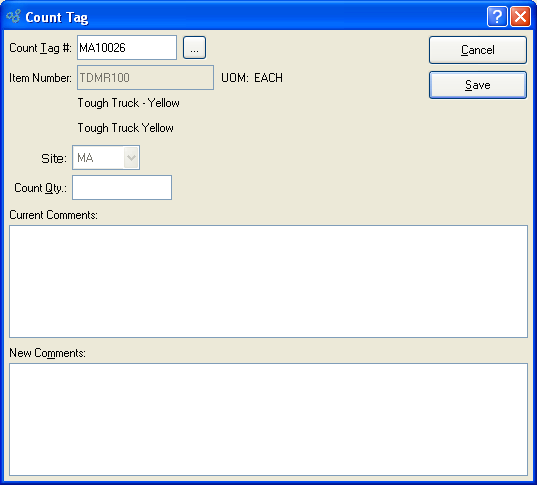
When entering a Count Tag, you are presented with the following options:
- Count Tag #
Enter the Count Tag Number of the Count Tag you want to enter details for.
- Item Number
Displays Item Number automatically when Count Tag Number is entered into "Count Tag #" field.
- UOM
Inventory Unit of Measure.
- Site
Displays Site where count will take place.
- Count Qty.
Enter the Physical Count total.
- Current Comments
Display lists all Comments added prior to the current session.
- New Comments
This is a scrolling text field with word-wrapping for entering Comments related to the Count Tag. Use the Comments field to enter any instructions or other Comments that need to reach and be read by the cycle counters.
To the far right of the screen, the following buttons are available:
- CANCEL
Closes the screen without creating a Count Tag, returning you to the application desktop.
- SAVE
Creates Count Tag and adds specified quantity to the Count Tag total.
Miscellaneous Inventory counts can be used to enter Inventory totals without engaging the Count Tag or Count Slip mechanisms. Entering a miscellaneous Inventory count is a simplified method for entering Inventory counts. To enter a miscellaneous Inventory count, select the "Enter Misc. Inventory Count" option. The following screen will appear:
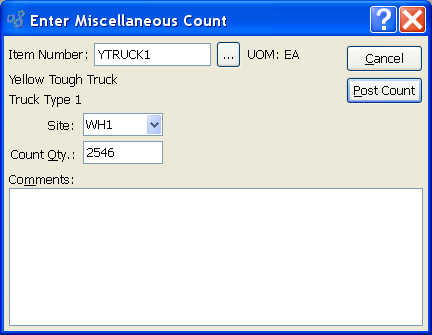
When entering a miscellaneous Inventory count, you are presented with the following options:
- Item Number
Enter the Item Number of the Item you want to enter a miscellaneous Inventory count for.
- UOM
Inventory Unit of Measure.
- Site
Specify the Site where you want to record the miscellaneous Inventory Count. This field will remain blank until you enter an Item Number into the "Item Number" field. Once that is entered, the Site(s) where the Item is located will display in the list.
- Count Qty.
Enter the miscellaneous Count total.
- Comments
This is a scrolling text field with word-wrapping for entering Comments related to the Count Tag.
Tip
To view a miscellaneous Count total that has been entered into the system, open any of the Physical Inventory displays featuring Count Tags. While a miscellaneous Count is not assigned a Count Tag number, its total will be shown in these Physical Inventory displays.
To the far right of the screen, the following buttons are available:
- CANCEL
Closes the screen without posting a miscellaneous Count, returning you to the application desktop.
- POST COUNT
Posts miscellaneous Count. Count quantity is added to the total Quantity on Hand.
In the event that Count Tags remain uncounted for a excessive period of time, you have the ability to enter for these uncounted Count Tags a quantity of zero ("0"). Entering a non-null value of zero makes it possible to process and post the Count Tags. To reset the counted values of uncounted Count Tags to zero, select the "Zero Uncounted Count Tags by Site" option. The following screen will appear:
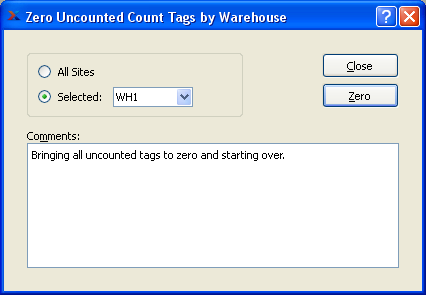
When zeroing uncounted Count Tags by Site, you are presented with the following options:
- All Sites
Select to reset uncounted Count Tags to zero for all Sites.
- Selected
Specify Site where uncounted Count Tags are to be zeroed.
- Comments
This is a scrolling text field with word-wrapping for entering Comments related to the zeroing process.
To the far right of the screen, the following buttons are available:
- CLOSE
Closes the screen without resetting uncounted Count Tags to zero, returning you to the application desktop.
- ZERO
Resets uncounted Count Tags values to zero.
To thaw previously frozen Item Sites by Class Code and Site, select the "Thaw Item Sites by Class Code Site" option. The following screen will appear:
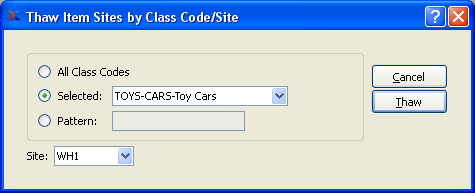
When thawing previously frozen Item Sites by Class Code and Site, you are presented with the following options:
- All Class Codes
Select to thaw Item Sites by Site for all Class Codes.
- Selected
Specify Class Code whose Item Sites by Site you want to thaw.
- Pattern
Enter a Class Code pattern to select a range of Class Codes. Refine your search using Regular Expressions.
- Site
Specify Site whose Item Sites are to be thawed.
To the far right of the screen, the following buttons are available:
- CANCEL
Closes the screen without thawing previously frozen Item Sites, returning you to the application desktop.
- THAW
Thaws previously frozen Item Sites by specified Class Code(s) and Site.
To post Count Slip totals to their respective Count Tag totals by Site, select the "Post Count Slips" option. The following screen will appear:
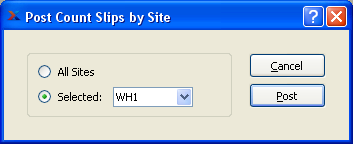
When posting Count Slips by Site, you are presented with the following options:
- All Sites
Select to post Count Slips for all Sites.
- Selected
Specify Site where Count Slips are to be posted.
To the far right of the screen, the following buttons are available:
- CLOSE
Closes the screen without posting Count Slip totals, returning you to the application desktop.
- POST
Posts Count Slip totals to their respective Count Tag totals.
To post Count Tag totals (i.e., Inventory counts) to the Quantity on Hand for their respective Item Sites for an entire Site, select the "Post Count Tags" option. The following screen will appear:
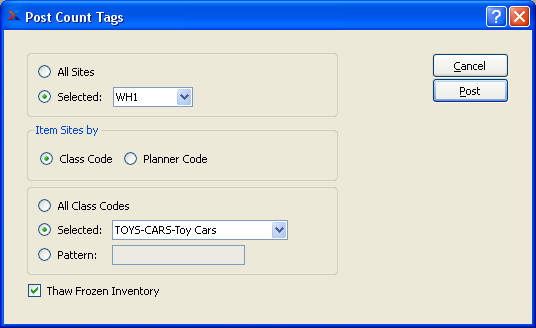
When posting Count Tags, you are presented with the following options:
- All Sites
Select to post Count Tags for all Sites.
- Selected
Specify Site where Count Tags are to be posted.
- Item Sites by
Specify which of the following codes you want to have Count Tags posted for:
- Class Code
If selected, you will be presented with Class Code options.
- Planner Code
If selected, you will be presented with Planner Code options
- Thaw Frozen Inventory
Select to thaw all previously frozen Inventory in specified Site(s).
To the far right of the screen, the following buttons are available:
- CANCEL
Closes the screen without posting Count Tags, returning you to the application desktop.
- POST
Select to post the specified Count Tags.
Purging Count Slips deletes the Count Slips from your system, freeing up disk storage space. To purge Count Slips from the system once they have been posted, select the "Purge Posted Count Slips" option. The following screen will appear:
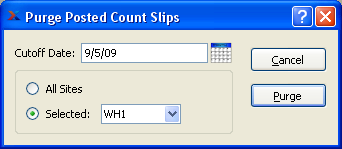
When purging posted Count Slips, you are presented with the following options:
- Cutoff Date
All posted Count Slips up to and including this date will be purged.
- All Sites
Select to purge posted Count Slips for all Sites.
- Selected
Specify Site where posted Count Slips are to be purged.
To the far right of the screen, the following buttons are available:
- CANCEL
Closes the screen without purging posted Count Slips, returning you to the application desktop.
- PURGE
Purges posted Count Slips from the system.
Purging Count Tags deletes the Count Tags from your system, freeing up disk storage space. To purge Count Tags from the system once they have been posted, select the "Purge Posted Count Tags" option. The following screen will appear:
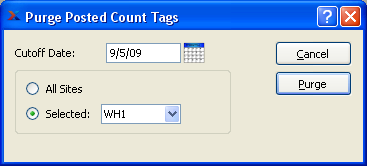
When purging posted Count Tags, you are presented with the following options:
- Cutoff Date
All posted Count Tags up to and including this date will be purged.
- All Sites
Select to purge posted Count Tags for all Sites.
- Selected
Specify Site where posted Count Tags are to be purged.
To the far right of the screen, the following buttons are available:
- CANCEL
Closes the screen without purging posted Count Tags, returning you to the application desktop.
- PURGE
Purges posted Count Tags from the system.
The Physical Inventory area contains its own reports section.
To display a list of Item Sites that have been frozen, select the "Frozen Item Sites" option. The following screen will appear:
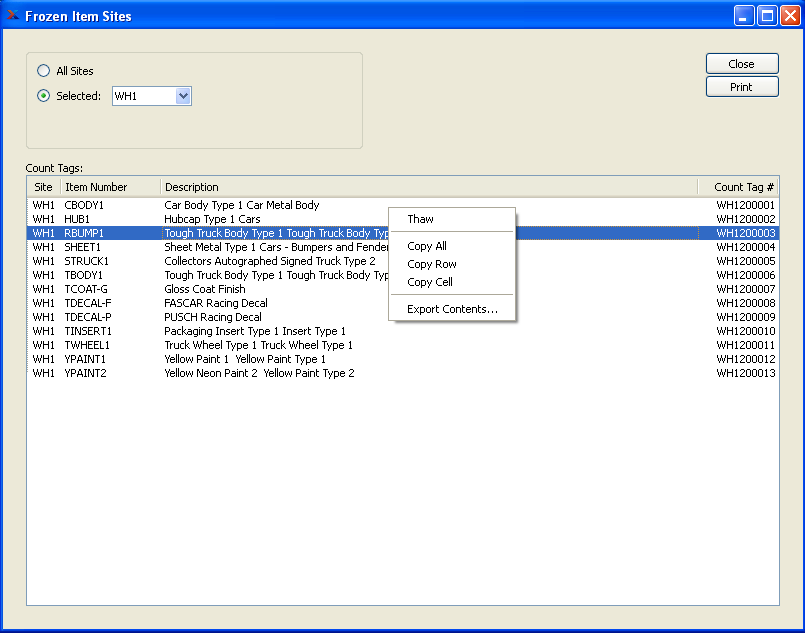
When displaying frozen Item Sites, you are presented with the following options:
- All Sites
Select to display frozen Item Sites for all Sites.
- Selected
Specify Site whose frozen Item Sites you want to display.
- Count Tags
Display lists frozen Item Sites, using the specified parameters.
To the far right of the screen, the following buttons are available:
- CLOSE
Closes the screen, returning you to the application desktop.
Runs the report associated with this screen.
To edit Count Slips entered for an associated Count Tag, select the "Count Slip Edit List" option. The following screen will appear:

When displaying the Count Slip Edit List, you are presented with the following options:
- Count Tag #
Enter the Count Tag Number of the Count Tag whose Count Slips you want to display.
- Item Number
Displays Item Number automatically when Count Tag Number is entered into "Count Tag #" field.
- UOM
Inventory Unit of Measure.
- Site
Displays Site where Count Tag and Count Slips originate from.
- Count Slips
Display lists the Count Slip Edit List, using the specified parameters.
To the far right of the screen, the following buttons are available:
- CLOSE
Closes the screen, returning you to the application desktop.
Runs the report associated with this screen.
- NEW
Opens screen for creating a new Count Slip.
- EDIT
Enables you to edit highlighted Count Slip. The edit screen is the same as that for creating a new Count Slip—except that when editing, the fields will contain Count Slip information. Double-clicking on a Count Slip will also bring you to the editing screen.
- DELETE
Highlight a Count Slip and then select this button to remove the Count Slip from the list.
- POST
Posts individual Count Slip quantities to the associated Count Tag's total. Highlight the individual Count Slip you want to post.
- POST ALL
Posts all Count Slip quantities displayed in the "Count Slips" list to the associated Count Tag's total.
The Count Tag Edit List displays the unposted Count Tags currently available in your system. From this list, you can manage current Count Tags and their associated Count Slips. To display available Count Tags, select the "Count Tag Edit List" option. The following screen will appear:
Tip
By default, the system allows only one unposted Count Tag per Item Site. Use the Count Tag Edit List to view all unposted Count Tags in your system.
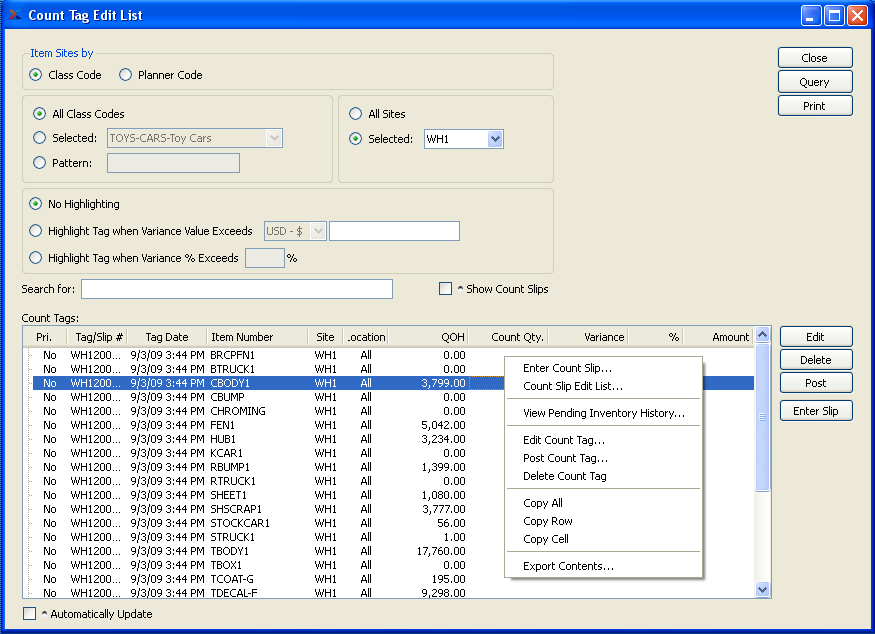
When displaying the Count Tag Edit List, you are presented with the following options:
- Item Sites in
Specify which of the following codes you want to have Count Tag displayed for:
- Class Code
If selected, you will be presented with Class Code options.
- Planner Code
If selected, you will be presented with Planner Code options.
Tip
One way to manage Count Slips associated with a Count Tag is by using the right-click menu options available from the Count Tag Edit List.
- All Sites
Select to display Count Tags for all Sites.
- Selected
Specify Site whose Count Tags you want to display.
- No Highlighting
Select to not highlight Count Tags with variances.
- Highlight Count Tag when Variance Value Exceeds
Select to highlight Count Tags whose dollar amount variance exceeds the value entered. In addition to checking the box, you must also enter a value in the field. Once the value is entered, select the QUERY button. Count Tags meeting your criteria will automatically be highlighted in red.
Note
Count Tags showing both positive and negative variances will be highlighted. For example, if you enter "100" in the field "Highlight Count Tag When Variance Value Exceeds," all dollar amount variances greater than $100 will be highlighted, but so too will negative variances exceeding -$100. The same principle holds true if a percentage value is entered.
- Highlight Count Tag when Variance Exceeds %
Select to highlight Count Tags whose variance exceeds a user-defined percentage. In addition to checking the box, you must also enter a percentage in the percentage field. Once the percentage is entered, select the QUERY button. Count Tags meeting your criteria will automatically be highlighted in red.
- Search For
To search for a Count Tag in the edit list, begin typing in the search field. As you type, the list will automatically scroll toward the Count Tag you are typing. You can also search for Count Tags manually by scrolling through the list.
- Show Count Slips
Select to display Count Slips associated with Count Tags. Count Slips will display in a nested manner beneath their associated Count Tag. Look for a plus "+" sign in the first column to determine if Count Slips are associated. Select the plus "+" sign to reveal the Count Slips. To hide the Count Slips, select the minus "-" sign.
- Count Tags
Display lists Count Tag Edit List, using the specified parameters. If the count quantity displays in blue type, this means the Item has not been counted.
Tip
Count Tags may be created to count an entire Item Site—or a specific Site Location within an Item Site.
To the far right of the screen, the following buttons are available:
- CLOSE
Closes the screen, returning you to the application desktop.
- QUERY
Select to generate the display, using the specified parameters.
Runs the report associated with this screen.
Note
The Count Tag Edit List supports multiple-select, using the SHIFT and/or CTRL keys.
- EDIT
Enables you to edit highlighted Count Tags. The edit screen is the same as that for creating a new Count Tag—except that when editing, the fields will contain Count Tag information. Double-clicking on a Count Tag will also bring you to the editing screen.
- DELETE
Highlight a Count Tag—or group of Count Tags using the SHIFT and/or CTRL keys—and then select this button to remove the Count Tag from the list.
- POST
Highlight an individual Count Tag—or group of Count Tags using the SHIFT and/or CTRL keys—and then select this button to post the Count Tag(s). Posts Count Tag quantities to the Quantity on Hand for the associated Item Site(s)
- ENTER SLIP
- Automatically Update
Select to automatically update the display every five minutes.
To view a display of Count Slips by Site, select the "Count Slips by Site" option. The following screen will appear:
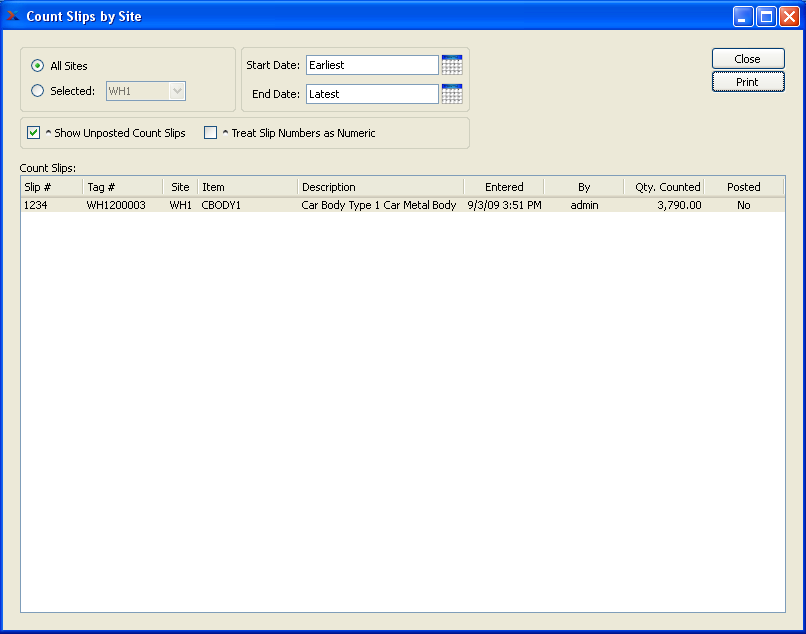
When displaying Count Slips by Site, you are presented with the following options:
- All Sites
Select to display Count Slips for all Sites.
- Selected
Specify Site whose Count Slips you want to display.
- Start Date
Count Slips entered on and after this date will be displayed.
- End Date
Count Slips entered on and before this date will be displayed.
- Show Unposted Count Tags
Select to display unposted Count Tags.
- Treat Slip Numbers as Numeric
Select to treat Count Slip numbers as numeric. If selected, the display will treat existing Count Slips as if they were created in a numerical sequence. If numbers are missing from the sequence, the display will indicate the missing Count Slip numbers in red type.
- Count Slips
Display lists Count Slips by Site, using the specified parameters.
To the far right of the screen, the following buttons are available:
- CLOSE
Closes the screen, returning you to the application desktop.
Runs the report associated with this screen.
Count Tag Reports section.
To view a display of Count Tags by Item, select the "Count Tags by Item" option. The following screen will appear:
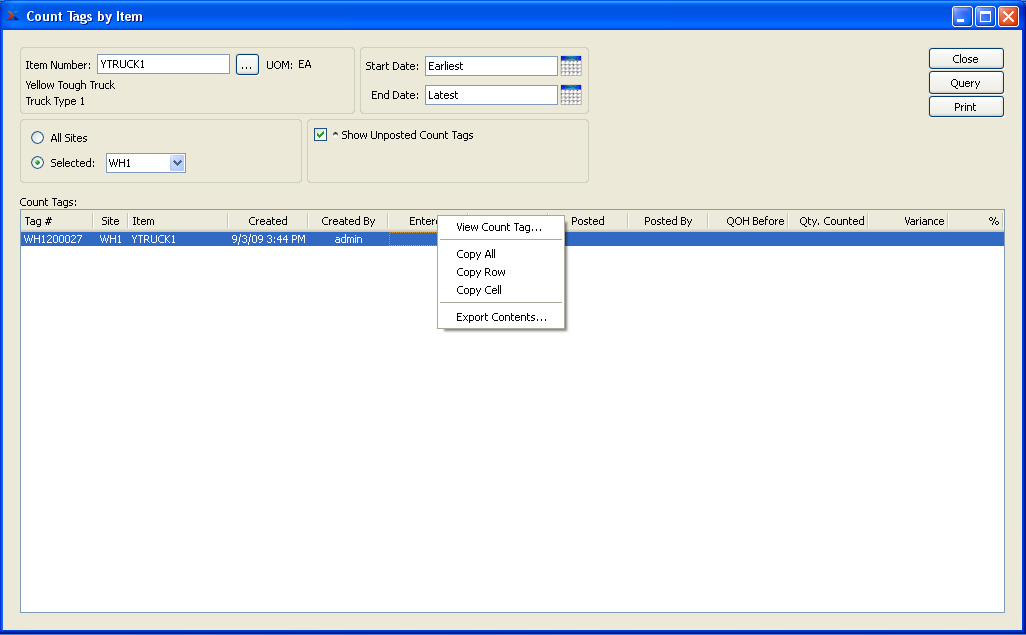
When displaying Count Tags by Item, you are presented with the following options:
- Item Number
Enter the Item Number of the Item Count Tags you want to view. The browse button located to the right of the field leads to a searchable list of make and buy items.
- UOM
Inventory Unit of Measure.
- All Sites
Select to display Count Tags for all Sites.
- Selected
Specify Site whose Count Tags you want to display.
- Start Date
Count Tags entered on and after this date will be displayed.
- End Date
Count Tags entered on and before this date will be displayed.
- Show Unposted Count Tags
Select to display unposted Count Tags.
- Count Tags
Display lists Count Tags by Item, using the specified parameters.
To the far right of the screen, the following buttons are available:
- CLOSE
Closes the screen, returning you to the application desktop.
- QUERY
Select to generate the display, using the specified parameters.
Runs the report associated with this screen.
To view a display of Count Tags by Site, select the "Count Tags by Site" option. The following screen will appear:
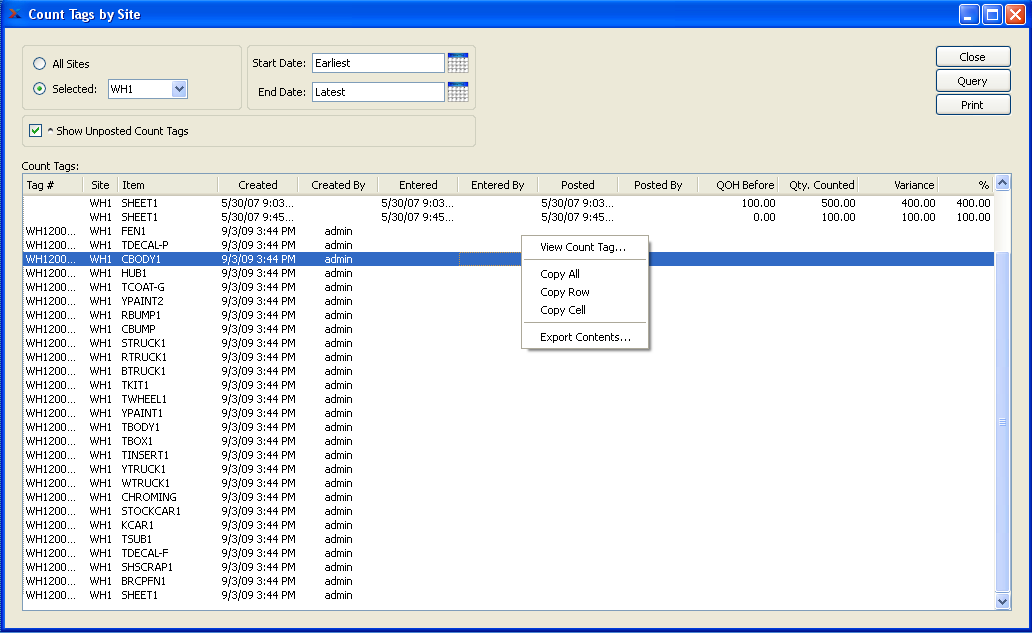
When displaying Count Tags by Site, you are presented with the following options:
- All Sites
Select to display Count Tags for all Sites.
- Selected
Specify Site whose Count Tags you want to display.
- Start Date
Count Tags entered on and after this date will be displayed.
- End Date
Count Tags entered on and before this date will be displayed.
- Show Unposted Count Tags
Select to display unposted Count Tags.
- Count Tags
Display lists Count Tags by Site, using the specified parameters.
To the far right of the screen, the following buttons are available:
- CLOSE
Closes the screen, returning you to the application desktop.
- QUERY
Select to generate the display, using the specified parameters.
Runs the report associated with this screen.
To view a display of Count Tags by Class Code, select the "Count Tags by Class Code" option. The following screen will appear:
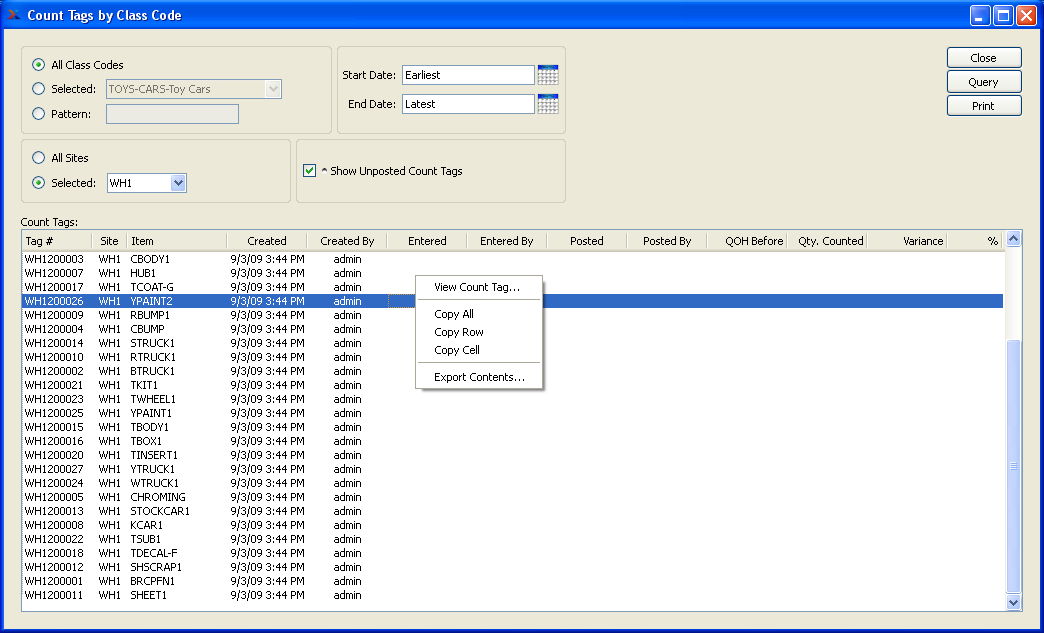
When displaying Count Tags by Class Code, you are presented with the following options:
- All Class Codes
Select to display Count Tags for all Class Codes.
- Selected
Specify Class Code whose Count Tags you want to display.
- Pattern
Enter a Class Code pattern to select a range of Class Codes. Refine your search using Regular Expressions.
- All Sites
Select to display Count Tags for all Sites.
- Selected
Specify Site whose Count Tags you want to display.
- Start Date
Count Tags entered on and after this date will be displayed.
- End Date
Count Tags entered on and before this date will be displayed.
- Show Unposted Count Tags
Select to display unposted Count Tags.
- Count Tags
Display lists Count Tags by Class Code, using the specified parameters.
To the far right of the screen, the following buttons are available:
- CLOSE
Closes the screen, returning you to the application desktop.
- QUERY
Select to generate the display, using the specified parameters.
Runs the report associated with this screen.